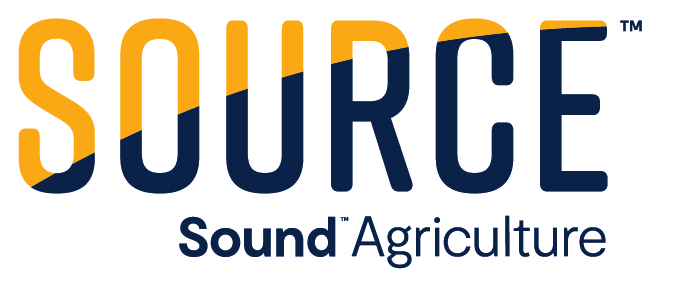On this edition of the Strip-Till Farmer podcast, brought to you by Sound Agriculture, Kuhn Krause marketing director Curt Davis examines the evolution of the strip-till equipment market and why the conservation practice is becoming an increasingly popular option for farmers.
"With strip till, you're not painting with a broad brush anymore," Davis says. "Strip-till allows you to manage every acre of the farm for maximum efficiency and productivity. A lot of farmers are driven to strip-till because it allows them to place nutrients exactly where the crop needs them.
It's a good conservation practice too because you're only tilling 30% of the entire field. Nutrient placement is the most important aspect, but compaction management is also key — getting air into the soil profile around the root system is just as important as water."
A momentous 4-month stretch in the strip-till equipment market continued with the recently announced technology partnership between Case IH and AGuru Machinery, as covered extensively on Strip-TillFarmer.com. Other big moves in 2023 include the launch of John Deere’s new strip-till units and Unverferth’s acquisition of Orthman. Yetter and Fast Ag Solutions are also launching a new strip-till bar this summer.
Curt Davis breaks down the significance of the latest developments, explains why more manufacturing companies are investing in strip-till and why the practice appears to be mainstream bound.
Watch the VIDEO REPLAY of this podcast.
The Strip-Till Farmer podcast is brought to you by SOURCE®️ by Sound Agriculture.
SOURCE provides 25 lbs of nitrogen and 25 lbs of phosphorus, leading to more productivity and supporting your fertilizer reduction goals. This foliar applied biochemistry has a low use rate and is tank mix compatible, getting a free ride into the field. Check out SOURCE — it's like caffeine for microbes. Learn more at www.sound.ag
Full Transcript
Hey, welcome into another edition of the Strip Till Farmer Podcast, brought to you by Sound Agriculture. I'm your host, Noah Newman. Today we're visiting with Jason Webster, Precision Technology Institute, AKA PTI, Farm Manager, and he'll discuss the biggest strip till lessons learned from years of research at the 400-plus acre research farm. We'll talk about why flexibility is key to strip till success, what to do when plan A doesn't quite worked out, and how fall strip till stacks up to spring strip till. Webster will also preview some of the topics he's going to talk about during his keynote presentation at the National Strip Tillage Conference August 2nd through 4th in Bloomington, Illinois. Let's jump right into the conversation.
All right, Jason. Well, great to have you with us here today. Thanks for taking the time to join us. For people who aren't familiar with you and the work you do at PTI Farm, just give our audience an idea of your background and your origin story, how you got started in agriculture.
Jason Webster:You bet. Well, I started farming when I was a junior in high school, actually. It was back in 1988. I knew I always wanted to be involved in farming and got the opportunity at a young age and ever since that year, 1988, along with farming we've been conducting field research trials ever since. Currently, we have a 400 acre farm in Pontiac, Illinois for precision planning. This farm is called the PTI Farm, the Precision Technology Institute. 400 acres of nothing but what we call agronomy 101. We certainly test a lot of the technology and the products that we have to offer from Precision Planting, but we also like to test really every management decision the farmers have to ask themselves on their farm. What we do here is we do the testing and then when the calendar flips over to July, August, and September, we invite growers, farmers from all over the world to come to our PTI Farm and we just talk about what agronomic problems we have in the field and then what are some potential solutions to those problems.
We have thousands of growers that come out to the farm over the summertime and we simply have a conversation out in the field. It is a lot of fun. Once summer passes us by, we get into harvest, we collect all of our data, we put it into a usable form, make it available to our dealers that they can provide to their customers, and it's just all about return on investment. It's about farm sustainability. What are we doing at this farm that can allow a grower to be more efficient or make more dollars on a per acre basis? That's what it's all about.
Noah Newman:Wow. It sounds like busy season year-round for you guys. It never ends over there. When we talk about strip till, how much has the practice of strip till taken off since you started the PTI Farm research?
Jason Webster:When we started the research farm here back in 2018, one of my goals was to be a hundred percent strip till on this farm. We actually wanted it to be narrow rows at that time. We're still working on that, but a large majority of our farm is strip till and I really enjoy using strip till at this farm. I think it has been absolutely amazing. We're comparing it to other tillage programs that are available for growers to use on their farms. We're putting strip till head-to-head against conventional tillage. That's what my father and grandfather taught me how to do as I was younger is till the soil. I just thought, gosh, there's got to be a better way of doing this in some years and strip till was, I think that better way.
We're comparing it to no-till, vertical till, all of the major tillage programs that are out there. We also talk about the major advantage of strip till being the opportunity to ban fertilizer at the same time we're doing our tillage. Lots of advantages with strip till. We're showcasing them at this farm and we're showing farmers how we failed, what are some of the things that we've done wrong with strip till, but what then are some of the things that we've really done well and it's all part of the learning experience that comes along with it.
Noah Newman:When you talk about how strip till stacks up against other tillage systems, you just touched on it, but it seems like just judging from what you're saying, is strip till pretty high in the power rankings, would you say, compared to other tillage systems?
Jason Webster:Well, we've been testing, so what we've got in the same area of this farm, we've been testing all of the major tillage programs. This will be the sixth year. Once we put our tillage programs in place, they never move. We just continue doing them every single year. Strip till over the last five years, this will be our sixth year in 2023, but strip till has been our overall winner when it comes to just tillage. We know it's unfair probably to compare it with banding fertilizer. That advantage would actually increase it to a certain degree, but we really like tillage. The numbers prove it, saying that it's the most profitable on this farm right now as a running average. Yeah, we've got the numbers to prove it. It's been very successful on this farm.
Noah Newman:And then how important is it to be flexible? When you're strip tilling? Does the plan A always work for people when it comes to strip till?
Jason Webster:We teach our growers that with strip till, we need to have a plan a, plan B and a plan C. Plan A is strip till and it goes just perfect, accordingly to plan. Plan B, however, is maybe we didn't weather through the winter properly. Maybe we need to rejuvenate those strips a little bit. We talk about freshening strips and things like that and making a really good seed bed, fixing strip, if you will. And then plan C is let's tear it up and start over. Sometimes it happens. I don't know that it's happened here yet at the PTI Farm, but we always tell folks that that's something that could happen. You're going to have to start from scratch again. But remember, we're still banding the fertilizer. We're still going to plant into those trips even though we may have to do a corrective tillage program to get that seed bed in place. But that's our plan A, plan B, plan C.
Noah Newman:Have you done studies on fall strip till versus spring strip till and what comes out on top?
Jason Webster:Yeah. We're primarily fall strip till here. I'm using strip till for my deep tillage. I guess when I talk to growers, I talk about field compaction. As a grower, as a farmer myself, I know I'm making some compaction to a degree. Now, I'm not trying to, but I know it's happening with large combines, large tractors, large auger carts, what have you. But we're using strip till to get us that lift and that fracture to break through that soil density that we could possibly be creating. To do that, on fall strip till I'm using the deep mole knife application process and building a very nice strip. Now, one of the things that we like this for, not only the compassion or the soil density, but I need a wide strip. One of the things we talk about a lot with our growers is when we do strip till, the strip has to be wide enough so the planter then, when we come in in the spring, the planter fits.
A lot of times, growers will use an anhydrous toolbar to make a strip. The strip looks nice, but it's too narrow. They bring their planter in and the gauge wheels fall off the side of the strip and then when they start planting, we're getting all this dance in their planter chatter happening and we're losing that performance on the planter and we're going backwards a little bit. With deep tillage in the fall, I can make that nice wide strip and it just plants like a dream in the spring. If I turn around and go to spring strip till, I can't do the deep type tillage because we're just usually not fit. We're too wet underneath and we're just going to be causing air pockets and causing more soil density issues if we do it. One of the things we're wanting to do if we incorporate more spring strip till is go to more of a vertical type strip till bar versus that deep mole knife.
Noah Newman:Let's burn a quick timeout and share a message from our sponsor, Sound Agriculture. Source provides 25 pounds of nitrogen and 25 pounds of phosphorus leading to more productivity and supporting your fertilizer reduction goals. This foliar applied biochemistry has a low use rate and is tank mix compatible, getting a free ride into the field. Check out Source. It's like caffeine for microbes. Learn more at www.sound.ag. Now back to the conversation.
What have you seen when you compare shanks versus coulters just in terms of the advantages of each one? Does it just depend on the situation or the soil type when would be best to use a shank or a coulter?
Jason Webster:Well, I think it depends on each individual program. The one thing that scares me about the vertical tillage trip till programs, the culture type is fertilizer application. Now, if we're shallowing up that tillage depth and we got that fertilizer potentially right where that seed is at, that's going to make a huge deal on what type of fertilizer a grower is using and then when he is doing it. Is he going to do it in the spring? Is he going to do it close to planting time, having a salt load fertilizer there? That is a concern. With us in the fall doing our strip till, we don't have any concern. We're placing that fertilizer, most of it six to eight inches deep, so we're going to be underneath that seed placement and planting time in the spring. It's been a nice program for us, but I don't know that there's one cookie cutter approach that's best for everybody. It all depends on what guys are using for fertilizer and how they want to place it.
Noah Newman:Gotcha. We're really excited. We're going to have you giving a general session presentation at the National Strip Tillage Conference August 2nd through 4th in Bloomington, Illinois. Close to your neck of the woods there. What could people expect from your presentation? What kind of stuff are you going to be touching on?
Jason Webster:Well, I thought we'd break it down and talk about maybe the six major things we've learned from strip till here at Precision Planting's PTI Farm. Number one, we thought we'd just share our data of strip till compared to the other tillage programs. What is the yield difference? What has it been? And then more importantly, once we put a dollar per acre cost to each program, how does each one of them compare to each other? What has been the best and what is the dollar difference on a per acre basis? Then I want to talk about banding versus broadcast applications of fertilizer. Due to the high cost of fertilizer right now, the historic high levels of fertilizer that we have, we've got to farm smarter and to do that, it's not broadcasting or sometimes what I call slinging fertilizer on every square inch of our soil. We'll talk about some of the long-term data we've done with banding versus broadcast, putting those dry fertilizer applications in a band underneath where we're planting, and show some of the differences in yield and then most importantly, net return.
We're doing that in both corn and soybeans. Most all of our trials are in both corn and soybeans. That's one thing growers ask me all the time is, okay, strip till is for corn, right? What are you doing for soybeans? We say, well, we're doing strip till for soybeans, too. It works just the same. As a matter of fact, one of the other things we'll talk about at the Strip Till Conference is why we're using strip till in regard to early plant soybeans. Some of our planting data has been really encouraging planting soybeans early, but how do you do it if you're in a no-till situation? We've got colder, maybe wetter soils. We use strip till to make that wide band that I talked about earlier. You've got that nice black soil grabbing all that heat from the sun, that thermal radiation warms the soil up where I can sneak in and plant some of my early plant beans and it's really been successful for us.
We'll also talk about liquid versus dry fertilizer. As we traveled the country this winter, it was really interesting talking with growers that do strip till, but some growers use dry fertilizer, others use liquid fertilizer. We're in our first year of testing looking at liquid formulations of fertilizer in strip versus alcohol status quo, typical damp and potash dry formulation. We'll talk about some of those differences that we've got here on the farm. Fertilizer rate efficiency. I think coming back to this high price of fertilizer, I mentioned we need a farm smarter. If we can go to a band in a strip till rather than surface broadcast applications, one of the questions we get a lot from growers is, well, if I'm banding fertilizer, can I use less of it? Due to the high cost of fertilizer, that is a legitimate question.
We're going to talk about some of our results of can we reduce fertilizer if we are in a band in our strip till? Right now, that answer is yes. We're still trying to study it, but right now our data would say that we could be a 25 to 50% reduction of fertilizer as long as we're in a band. Some exciting numbers there that we'll talk about. Lastly, we're going to incorporate cover crops into our strip till situation. Cover crops are a great way to hopefully increase soil health or improve soil health, but there's some management that comes along the way that is a little difficult for growers. My experience has been corn and soybean yield has gone lower as we've tried to incorporate crop programs out on the farm.
We're using strip till as a way to make it a lot easier to manage crops and it's still giving us the ability to ban fertilizer and not let the cover crop and then the new crop of corn soybeans compete with each other. We've got enough nutrition in place so nothing slows us down and we're full bore ahead. We've got some long-term studies. We've got corn after corn, corn after soybeans, and then soybean after corn. This is designed as a 10-year program. A lot of things we'll talk about at Strip Till Conference are 10-year programs where we're looking at long-term and really trying to figure out the differences of what we're trying to evaluate in the field.
Noah Newman:Well, this is going to be an action packed presentation. I can't wait for this. A lot of information you're going to be squeezing in there, so we look forward to that. Also, before the conference gets started with the presentations and everything, there's going to be a special pre-conference workshop at the PTI Farm. Tell us a little bit about that. What can attendees expect?
Jason Webster:Yeah. We're excited about the pre-conference meeting here at the farm. We're going to take folks out. We'll have three different sessions here at the farm. We'll have one, it'll be an agronomy tour with me and my team. We'll go out in the field, we'll talk about some of the things that we've already mentioned. We'll show some of the trials we have in place here this year out in the field growing here at the farm. We'll have some data slides where we'll talk a little bit about what we've seen. I'm excited about that. Then we'll give a glimpse of the rest of the farm, some of the other agronomy that we're doing as part of a sustainability project here at the farm. We have a water management program where we recycle rainwater to do some of our irrigation and fertigation work here at the farm.
It's just a really neat program. We'll talk about the benefits of that as well as some of the other things that we're doing. We'll also have a sandbox area, is what we affectionately call it, at the farm where my goal is to have every strip till piece of equipment available to growers at the farm where growers can kick the tires a little bit and say, okay, what's currently available in the marketplace and what equipment might be best for their farm? They'll be able to talk with the industry experts and just see the differences. That's half the battle with farmers, just knowing what's available in the marketplace. I hope the pre-conference meeting is a great way to help with that challenge.
Noah Newman:Yeah, definitely. Looking forward to it. August will be here before we know it, and I know you're going to be busy there once the weather gets a little bit better in central Illinois. Thanks for taking the time to join us today, Jason.
Jason Webster:Absolutely. Thanks and we're looking forward to the summer.
Noah Newman:That'll wrap things up for this week's edition of the Strip Till Farmer Podcast. Thanks to our sponsor, Sound Agriculture. You can hear more from Jason Webster at the National Strip Tillage Conference, August 2nd through 4th in Bloomington, Illinois. Registration is currently underway. You can also lock up a spot to that pre-conference workout Jason talked about as well. I'll be there. Hope to see you there. Until next time, for all things strip till, head to striptillfarmer.com. Have a great day.











